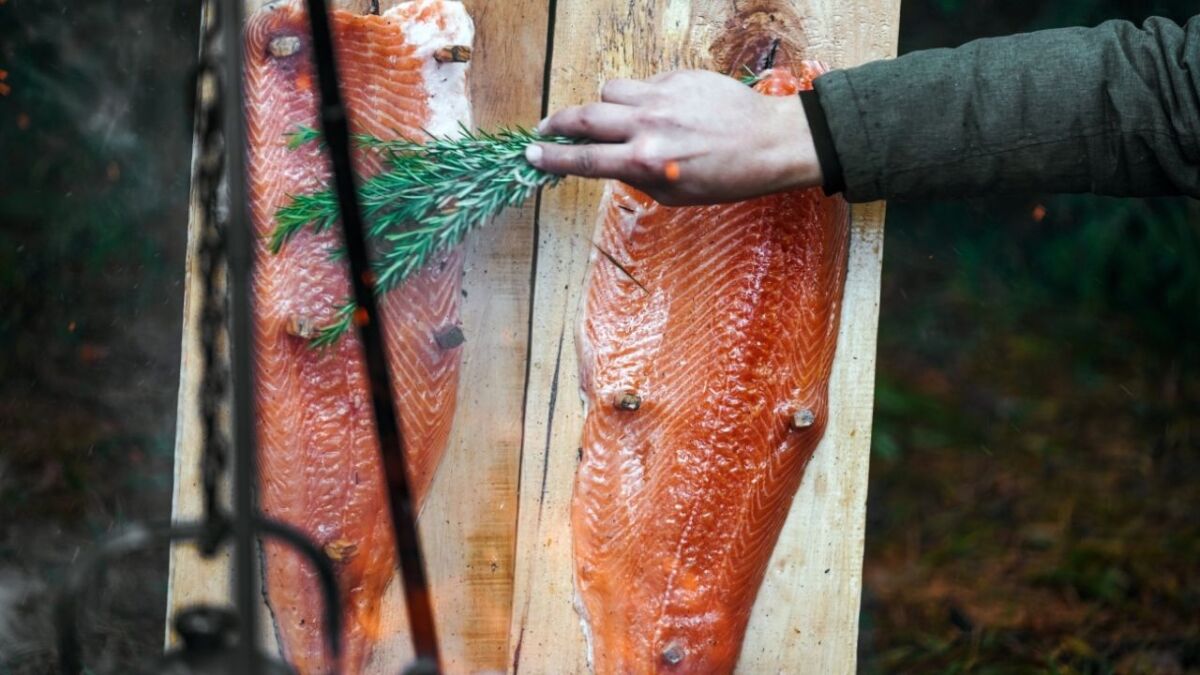
smoke food
Nomen
Meaning
Smoke food is a traditional method of preserving and flavoring food in the outdoor realm. It involves exposing food to smoke from burning wood or other combustible materials. This process not only imparts a delicious smoky flavor to the food but also helps to extend its shelf life by inhibiting the growth of bacteria and other microorganisms.
In the context of survival, bushcraft, wilderness, camping, and hiking, smoke food is a valuable skill to have. It allows you to store and carry food for longer periods without refrigeration, making it ideal for extended trips or emergency situations. Additionally, the smoky aroma and taste can enhance the overall outdoor dining experience.

Examples
„I love to smoke food when I go camping. It adds such a delicious flavor to the meat.“
„Last weekend, I smoked some fish for dinner. It turned out perfectly, with a smoky and savory taste.“
„My friend taught me how to smoke food using a homemade smoker. It was a fun and rewarding experience.“
„When you smoke food, make sure to use the right type of wood for the best flavor.“
„Smoking food is a great way to preserve it, especially when you're out in the wilderness.“
Origin
The word "smoke food" originates from the practice of smoking food as a method of preservation and flavor enhancement. It has its roots in ancient civilizations, where smoking was used to extend the shelf life of perishable food items.
Smoking food can be traced back to various cultures around the world, including Native American tribes, Scandinavian countries, and Asian countries. Each culture developed its own unique techniques and methods of smoking food.
Over time, the process of smoking food has evolved and become more refined. Initially, smoking was done by hanging food over an open fire, allowing the smoke to penetrate and preserve the food. Today, we have specialized smokers and smokehouses that control temperature and smoke levels for optimal results.
Smoking food not only helps to preserve it but also imparts a distinct smoky flavor. The smoke acts as a natural preservative by inhibiting the growth of bacteria and other microorganisms. Additionally, the smoke adds depth and complexity to the taste of the food, making it a popular cooking technique for meats, fish, and even vegetables.
Whether you're a seasoned survivalist or simply enjoy the taste of smoked food, understanding the art of smoking can greatly enhance your culinary skills and provide you with delicious meals even in the most challenging of circumstances.
Synonyms
Smoke meat, Smoke fish, Smoke jerky, Smoke cure, Smoke preserve
Antonyms
Cook food, Eat raw food, Freeze food, Preserve food, Throw away food, Waste food, Buy ready-made food, Order takeout food
Relatives
Smoked meat, Smoking techniques, Curing, Preserving, Barbecue, Flavor, Wood chips
Historical and cultural importance
Smoking food has a long and rich history that spans across different cultures and time periods. The practice of smoking food can be traced back thousands of years, with evidence of its use by ancient civilizations such as the Egyptians, Greeks, and Romans.
In many cultures, smoking food was not only a means of preserving it but also a way to enhance its flavor. The process of smoking involves exposing food to smoke from burning wood or other materials, which imparts a distinct smoky flavor and helps to extend its shelf life.
One of the most well-known examples of smoked food is smoked salmon, which has been a staple in many Native American cultures for centuries. The Native Americans would catch salmon during the annual migration and then smoke it over an open fire, allowing them to preserve the fish for the long winter months.
In addition to preservation, smoking food also played a significant role in religious and ceremonial practices. For example, in some Native American tribes, smoking food was seen as a way to honor the spirits and offer them sustenance.
Today, smoking food has become a popular cooking technique in many parts of the world. It is not only used for preservation but also for adding a unique and delicious flavor to various types of meat, fish, and even vegetables. Whether you are a fan of smoked barbecue ribs or smoked cheese, the art of smoking food continues to be appreciated and enjoyed by people from all walks of life.
More information about the term smoke food
Smoke Food: A Delicious and Time-Honored Survival Technique
When it comes to survival in the wild, one of the most important skills to have is the ability to preserve and store food. In this regard, smoking food has been a tried and true method for centuries. Not only does it help to extend the shelf life of perishable items, but it also imparts a unique and delicious flavor that can't be replicated by any other cooking method.
The Basics of Smoking Food
Smoking food involves the process of exposing it to smoke from burning wood or other combustible materials. The smoke acts as a natural preservative by inhibiting the growth of bacteria and other microorganisms that cause food spoilage. Additionally, the heat from the smoke helps to cook the food, making it safe to eat.
Traditionally, smoking was done in smokehouses or smoke pits, but in a survival situation, you can easily create a makeshift smoker using materials found in the wilderness. All you need is a fire pit, a rack or grate to hold the food, and some green branches or leaves to generate smoke.
Choosing the Right Wood for Smoking
The type of wood you use for smoking can greatly impact the flavor of the food. Hardwoods such as oak, hickory, and maple are popular choices as they produce a rich and smoky flavor. Fruitwoods like apple and cherry can add a subtle sweetness to the food, while mesquite imparts a bold and robust flavor.
It's important to avoid using softwoods like pine or cedar, as they contain resins that can give the food an unpleasant taste. Additionally, make sure the wood is dry and seasoned, as green or wet wood can produce excessive smoke and create a bitter flavor.
Preparing the Food for Smoking
Prior to smoking, it's essential to properly prepare the food. This typically involves marinating or seasoning it to enhance the flavor. You can use a variety of spices, herbs, and marinades to add depth and complexity to the taste.
It's also important to ensure that the food is properly cleaned and trimmed of any excess fat or skin. This helps to prevent flare-ups and ensures even cooking. For larger cuts of meat, such as whole chickens or roasts, it's recommended to brine them beforehand to help retain moisture and tenderness.
The Smoking Process
Once the food is prepared, it's time to start the smoking process. Place the food on the rack or grate, ensuring that there is enough space between each piece for the smoke to circulate. Light a fire in the fire pit and add the wood chips or green branches to generate smoke.
Control the temperature by adjusting the airflow. A lower temperature, around 225-250°F (107-121°C), is ideal for smoking as it allows the food to cook slowly and absorb the smoky flavors. Keep an eye on the fire and add more wood as needed to maintain a steady supply of smoke.
Enjoying the Fruits of Your Labor
Smoking food is not only a practical survival technique but also a rewarding culinary experience. After hours of patiently tending to the fire and allowing the smoke to work its magic, you'll be rewarded with tender, flavorful food that is sure to satisfy your taste buds.
Whether you're smoking fish, poultry, game meat, or even vegetables, the end result is a delicious meal that showcases the art of survival cooking. So next time you find yourself in the wilderness, don't forget to pack your smoking gear and indulge in the timeless tradition of smoking food.
Back to overview

